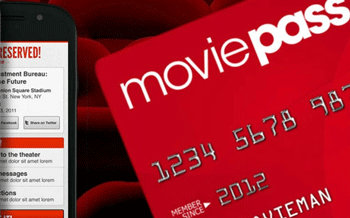MoviePass brings to the theaters what Netflix brought to streaming, with profound implications for the movie business.
______________________________
By Jeffrey Cole
Over the holidays I bought a MoviePass, partly to see if it really worked as advertised and partly because there were a lot of new movies (10 or so) that I wanted to see. Without MoviePass, I would have spent $160 (in Manhattan) to see those movies, although, in truth, if I were spending $16 a film, I probably would have seen only two or three of them.
 The MoviePass works exactly as advertised. For $9.95 a month (or $89.99 a year at Costco-$7.50 a month), I can go to one movie a day at almost any theater. The only restriction is that it does not include IMAX or 3-D screenings.
The MoviePass works exactly as advertised. For $9.95 a month (or $89.99 a year at Costco-$7.50 a month), I can go to one movie a day at almost any theater. The only restriction is that it does not include IMAX or 3-D screenings.
Theaters don’t like MoviePass, because they feel it devalues the movie-going experience. There is little they can do, because the MoviePass is a debit card, and as soon as I select a film on the app, it places the full value of the admission on the card, which I use to buy a ticket as with any credit or debit card.
The people behind MoviePass spent $162.90 for my ten admissions while collecting only $9.95 from me. If I see no more movies this month, they are out $152.95. Sounds like an impossible financial plan, but they believe they will get that money back from selling the data they collect on my movie habits and hoping I rarely see ten movies a month.
The movie theater habit is declining. Summer box office hit a 25-year low and, while revenues were up for the year, it was only because of an increase in ticket prices. Actual attendance was down four percent.
The Center’s work shows that 2017 was the first time we can see the direct impact of Netflix (and Amazon and Hulu) on the theatrical business. A film in the theaters for as much as $16 becomes a risky venture compared to $10 for a month of Netflix. Theaters used to have the strong advantages of better content with bigger stars and a much higher-quality screen. No longer. Dinner and a movie has become Netflix and Uber Eats.
_________________________________________________________________________________________________
What is indisputable is that subscription models at reasonable prices greatly increase interest and excitement in film, television, magazines, and music. The more people consume, the more they can share that experience through conversations and social media, and the more the media touches more people’s lives.
_________________________________________________________________________________________________
Going to the movies will never die, but we believe there will be fewer and fewer movies people will pay $16 for, particularly if they know little about the film. Stars Wars is safe — at least for now.
What I noticed immediately is that MoviePass got me to see many more movies than I normally would have over a holiday season. Film going is one of the last media activities that had not moved to an “all you can eat” subscription model. Theaters have held out hope for a long time that they can continue to get their customers to pay for each individual piece of content. MoviePass (and other incarnations likely to come) show that belief will not be sustainable much longer.
As my experience shows, the media subscription model increases interest in and consumption of content. It is very valuable for keeping viewers, readers, and listeners interested in new content and building habits of reading and watching. It removes significant financial barriers to experimenting with unknown content and increases willingness to take a chance.
Movie theater attendance has been declining continually since the 1940s. In 1946, 4.3 billion people a year bought movie tickets in North America. Last year, with a population more than double 1946, about 1.2 billion tickets were sold — about 1/8 of the 1946 rate. A subscription model is one of the only things that can keep movie attendance from eventually dropping off a cliff.
In their recent prime, the music companies loved their business model, which was, “if you like two songs, then you have to spend $17 for a CD.” That worked, and people paid for music they didn’t want. But as soon as there were alternatives available people got only the music they wanted.
When the music companies refused to change their business models to accommodate downloading two songs, customers went to illegal downloading services such as Napster. When the companies reluctantly accommodated their customers, music buying habits changed, and then they changed even further as iTunes provided single-song downloads. In a matter of a few years, downloading gave way to streaming and “all you can eat” services such as Spotify and Pandora.
In the next three to four years, music revenues will surpass the revenues from the era before the Internet. This is an amazing development. However, where those music dollars go has been completely re-arranged.
_________________________________________________________________________________________________
The Center’s work shows that 2017 was the first time we can see the direct impact of Netflix (and Amazon and Hulu) on the theatrical business. Theaters used to have the strong advantages of better content with bigger stars and a much higher-quality screen. No longer. Dinner and a movie has become Netflix and Uber Eats.
_________________________________________________________________________________________________
The magazine business is in even more danger than film or television. Weekly magazines (such as Time) with a cover price of $5.95 an issue, sell yearly subscriptions for $16 and are seeing declining revenue even at those cut-rate prices.
For $7-$14 a month, Texture offers on-line access to approximately 200 magazines delivered to your computer, tablet or phone. In my case, subscribing to Texture increases my interest in all magazines and results in my reading many more magazines than I would have if I had to subscribe individually or buy at a news stand (are there even many news stands left?).
Television has had a subscription model like Texture for 50 years: it’s called cable and satellite television. Viewers can watch hundreds of channels with no individual costs (except HBO and other pay channels) but at a cost of $60-100 a month or more.
Now, for $10, Netflix gives viewers a choice of high-quality original productions (with big stars and in 4K if you have the set) as well as thousands of hours of old television and theatrical movies. It’s such a great subscription model at such a low cost that it is encouraging massive amounts of cord cutting and cord shaving.
Movies in the theater are the last form of media to introduce an “all you can eat” subscription model. Just as the music companies had no choice but to surrender the $17 for twelve songs when you only wanted two songs, so too may the theaters have to look longingly at the $16 per movie model. Sometimes businesses have to become smaller to survive (theatricals already have).
What is indisputable is that subscription models at reasonable prices (MoviePass may be unsustainable) greatly increase interest and excitement in film, television, magazines, and music. The more people consume, the more they can share that experience through conversations and social media, and the more the media touches more people’s lives.
Over the past ten years, everything about how we pay for and consume media has changed. No matter how much interested parties may object or try to block the change, it is irreversible.
__________

Jeffrey Cole is the director of The Center for the Digital Future at USC Annenberg.
See all columns from the Center.
January 11, 2018

